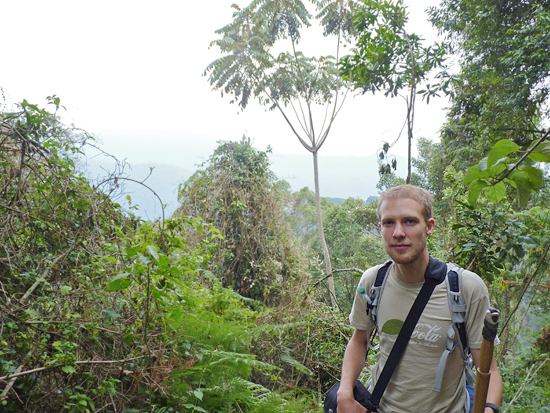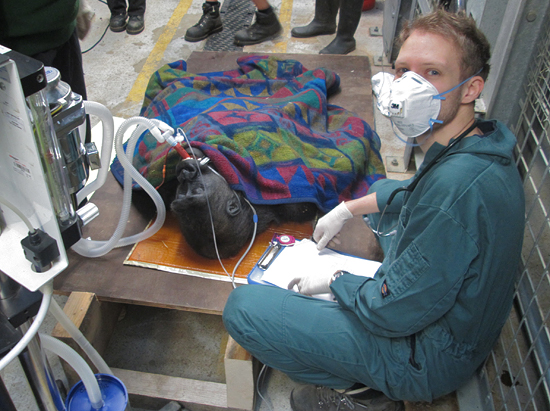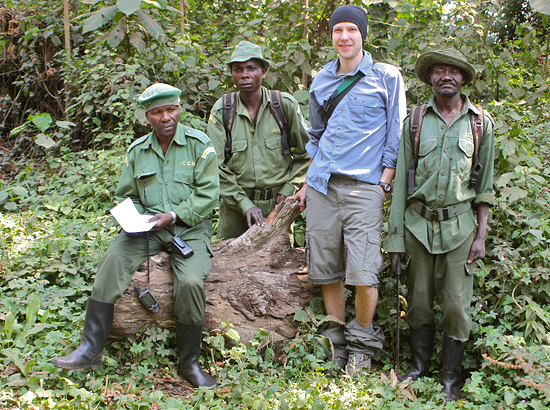James Hassell Studies Infant Mortality in Mountain Gorillas
By Gorilla Doctors Staff on Wednesday, August 28th, 2013 in Blog.As a critically endangered species, the health of each mountain gorilla is integral in assessing their long term survival in the Virunga Massif. When possible, the Gorilla Doctors conduct post-mortem exams on every deceased individual of the 19 habituated groups in Volcanoes National Park. Whether it be a tiny infant or a massive silverback, the body is carried down the steep slopes of the park and transported to the Gorilla Doctors headquarters in Musanze, Rwanda, where a complete necropsy is completed by our veterinarians. The painstakingly thorough process of a gorilla necropsy can last anywhere from 6-10 hours, where the vets will methodically collect samples, examine, measure and weigh every organ, as well as look for any internal injuries or signs of disease.
Unsurprisingly, the Gorilla Doctors have amassed a mountain of records containing post-mortem exam notes over the last 25+ years of work with mountain and Grauer’s gorillas. This has created a unique resource for Masters student and veterinarian James Hassell, who is currently looking at the gross and histopathological necropsy records of infants (from birth to 3.5 years of age), investigating causes of death and disease over time.
 Masters student and veterinarian James Hassell.
Masters student and veterinarian James Hassell.
According to Dr. Hassell, “infants form a particularly important age group, the variation in which may have a strong influence on population dynamics”. From the Gorilla Doctors‘ (formerly Mountain Gorilla Veterinary Project) inception in 1986 to 2013, over one hundred deceased infants have been examined for cause of death. Trauma is the clear front runner for infant mortality at 47%, while respiratory infections have claimed 15% of infant lives. Illnesses found that could have contributed to cause of death in mountain gorilla infants are gastrointestinal parasitism (15%), lymphoid disease (11%) and hepatic capillariasis (9%).
Beyond pinpointing the cause of death, “necropsy results help us to direct our work and learn which diseases we should concentrate on” says Gorilla Doctors director Dr. Mike Cranfield. “It also tells us “incidental findings” which, although subtle, can reveal genetic, environmental or minor health problems. We look for patterns of death with season and over time to be as effective as possible.”

Hassell is completing his MSc in Wild Animal Health at the Royal Veterinary College / Zoological Society of London. This is his second stay at our Musanze, Rwanda headquarters. In 2011, as he was finishing his Bachelor of Science and Veterinary Medicine degree, he spent 8 weeks in Rwanda studying disease transfer between cattle, buffalo, and the mountain gorillas in and around Volcanoes National Park. “Having the opportunity to work with the Gorilla Doctors in Rwanda for the second time has been a great privilege for me.”
 Masters student James Hassell with ICCN rangers in DRC.
Masters student James Hassell with ICCN rangers in DRC.
Hassell’s experience is diverse, having assisted with wild orangutan research in Borneo, research on predator-prey interactions in South Africa, and working in various veterinary hospitals and clinics in Great Britain. But his experience working with mountain gorillas in Rwanda’s forests “will always be the most memorable”.
“Being based at the Gorilla Doctors headquarters in Musanze has given me the opportunity to discuss the project with the veterinarians who have been responsible for collecting this data over the years, providing insight that otherwise wouldn’t have been available” says Hassell. “Some of the reports that I have been looking at date back to the very beginning of the Gorilla Doctors operations; it’s amazing to see how far the organization has come since then.”


 Donate
Donate